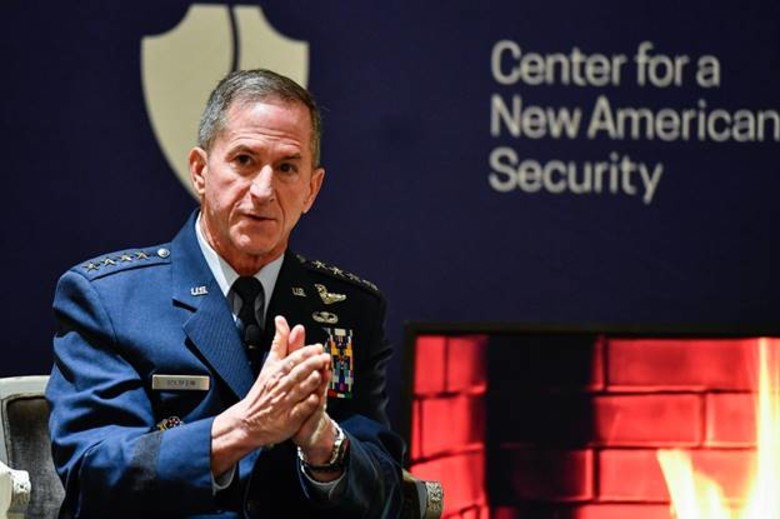U.S. highest-ranking military officer offers optimistic update on Air Force’s evolution and future
Posted on
Air Force Chief of Staff Gen. David L. Goldfein said during a Jan. 27 appearance at the Center for a New American Security that the service is making significant strides in harnessing and using data for deterrence, decision-making and warfighting while also maintaining dominance in space.
Creating a system that uses data, machine learning and state-of-the art software to seamlessly link “sensors to shooters” across all domains – air, land, sea, cyber and space – is among Goldfein’s highest priorities as the Air Force’s highest-ranking military officer.
“First and foremost, we have to connect the joint team,” he said in describing what’s necessary to prevail in the future fight. “We have to have access to common data so we can operate at speeds that will bring all our capabilities against an adversary.”
He also said that the creation of the Space Force as a separate branch of the U.S. military is critical to ensuring national security and to protect commerce and other national interests.
“You’ve got to dominate space. You will see some significant investment in space capabilities. It won’t be just enough to be in the ring and take some punches. At some point, you have to be able to punch back,” he said.
In his 50-minute remarks to the influential think tank, Goldfein noted the technical advances and cultural shifts that have moved the concept of tightly connected, joint warfare forward, not only in the Air Force, but across the entire U.S. military establishment.

“Based on where we started,” Goldfein said, “I will say we are having discussions on alignment of all services. How we talk about the business of joint warfighting in ways I have not seen in previous years.”
The concept, known as Joint All Domain Command and Control or JADC2, has been widely embraced as the critical transformation needed in an era in which Russia and China are emerging in addition to traditional threats.
That support, Goldfein said, has moved from rhetoric to action.
“We’re actually building the foundation,” he said. “We’re not talking about cloud architecture. We actually built one. It’s operating and up and running and all the services are connected in. We’ve actually built unified data libraries that are inclusive of all the services going forward.
“Are we where we need to be? No. This journey never ends,” he said.
While complex both technically and culturally, the effort is moving forward in distinct ways, he said. Last month, the Air Force, Navy and Army staged a joint exercise to test new methods and technology for collecting, analyzing and sharing information in real time to identify and defeat a simulated cruise missile. Among other advances, it featured new technology that allowed pilots flying F-35 Lightning IIs and F-22 Raptors to receive data simultaneously along with Army units on the ground, special forces and commanders.
Goldfein also pointed out that the Air Force has created a new “numbered Air Force” dedicated to information warfare.
“You have to do that foundational work, which is digital engineering and data architecture,” he said.
Those steps, along with increasing the number of Air Force operational squadrons to 386 from 312, refining logistics to make the Air Force “more agile on our feet,” ensuring readiness and powered by the priorities in the 2018 National Defense Strategy are transforming the service.
When asked how to reconcile the needs “of the future over the present,” Goldfein was direct.
“If we build what we need to defeat China and Russia, we’ll have everything we need to handle Iran,” he said. “If we build a force that just handles Iran, we’re not going to have what we need to handle a peer power.”
Though nascent and still developing, the changes have produced tangible results, Goldfein said. Previously simulated war games against peer competitors yielded distressing results. But the move to legitimately joint operations, continued prowess in space, the simulations suggest “we can actually win for the first time in years.”
In order to sustain progress, Goldfein said future budgets must be sufficient and the Space Force must be successful.
On that front, Goldfein said he and Gen. John Raymond, the newly designated chief of Space Operations, are working together closely.
“The objective for Chief Raymond and me is how do we build a foundation of trust and confidence and focused on integrated joint warfare. At the same time, how do we allow the Space Force to develop its own service culture,” he said.
“Right now I’m feeling pretty confident that Chief Raymond, Chief Goldfein and (Secretary of the Air Force Barbara Barrett) are on the right path.”
Subscribe to our newsletter
Promotions, new products and sales. Directly to your inbox.
